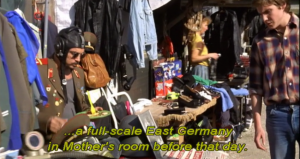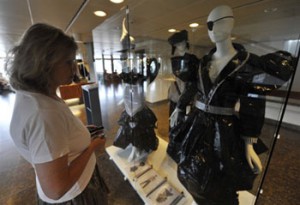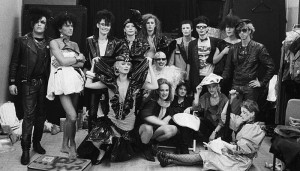Mit der Deutsche Wiedervereinigung in 1990 existiert die DDR nicht mehr, aber trotzdem gibt es noch heute die Erinnerungen der Mode der DDR. Um diese Erinnerung zu untersuchen, muss man auf Museums, aber auch auf Filme und Medien bauen, um die ganze Geschichte zu erzählen. Diese Museum und die Filme zeigen verschiedene Seite von der kollektiven Erinnerung der DDR Mode.
Museums wie das Kunstgewerbemuseum Berlins und das DDR Museum interessiert sich oft für die Gegenkultur. Kürzliche Ausstellungen wie die 2009 “In Grezen Frei: Mode, Fotographie, Underground, DDR 1979-1980” wollen Zeitschriften wie Sibylle hervorheben. Das Museum darstellt DDR Gegenkultur als ob es wichtiges Teil der Geschichte war, aber auch ein Symbol des Modernismus. Die Aufnahme der Gegenkultur in einem Museum symbolisiert auch westliche Anerkennung dieser Mode.
English: With the German reunification in 1990, East Germany no longer existed, however there are still reminders of the fashion. In order to examine these reminders, it’s necessary to tell the story not only through museums, but also through films and media. The museums and films show different sides of the collective memory of East German fashion.
Museums like the Museum of Decorative Arts in Berlin and the East Germany Museum often feature counterculture. Recent exhibitions like the 2009 “Freedom within Borders: Fashion, Photography, Underground, DDR 1979-1980” seek to highlight magazines like Sibylle. The museum depicts East German counterculture as an important part of the history, and also as a symbol of modernism. The inclusion of counterculture in a museum also symbolises the western recognition of this fashion.
In der Zeit nach dem Mauerfall erscheint es auch viele Dokumentarfilme, die die Widersprüche der DDR zu verstehen versuchen. Der 2009 Film Ein Traum in Erdbeerefolie dokumentiert die schöpferische und künstlerische Methode, die selbstständige Designer in der DDR benutzten, um Kleidung für Zeitschriften wie Sibylle zu machen. Der Filmmacher, Marco Wilms, wäscht in der DDR auf, und deswegen hat eine bestimmte Verbindung mit dieser Bewegung. Statt Gefühle von Ostalgie, interessiert er sich für die Gefühle, die Ostdeutschegegenkultur erreichte.
English: In the time after the fall of the Berlin Wall, many documentaries appeared that attempted to understand the contradictions of East Germany. The 2009 film Comrade Couture documents the creative and artistic methods the independent designers in East Germany used in order to make clothes for magazines such as Sibylle. The filmmaker, Marco Wilms, grew up in the GDR, and therefore has a certain connection with this movement. Instead of feelings of East German nostalgia, he is interested in the feelings that created East German counterculture.
Kleidung nimmt eine besondere Wichtigkeit in Good Bye Lenin an, als Alex versucht, die DDR nach zu bilden. Auch wenn der Film die Konflikt zwischen neu und alt zeigt, fokussiert er nicht auf der individualle, rebellische Ostdeutsche Stil von den Seiten der Zeitschrift “Sibylle”, sondern gewöhnliche Alltagsobjekte im Kontrast mit der neuen westlichen Produkte. In der Nachwendezeit interessiert Alex für die Halstücher der Freie Deutsche Jugend, statt die Haute Couture, von der der Film Ein Traum in Erdbeerfolie handelt.
English: Clothes take on a special importance in Good Bye Lenin when Alex tries to stage the now non-existant East Germany for his invalid mother. Although the film shows the conflict between new and old, he does not focus on the individual, rebellious East German style from the pages of the magazine “Sibylle”, but ordinary, everyday objects in contrast with the new Western products. In the post-wall period, Alex is interested in the neck kerchiefs of the Free German Youth, instead of the high fashion that Comrade Couture deals with.


